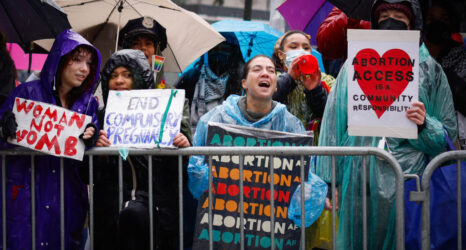A new state-by-state women’s health scorecard released this week by the Commonwealth Fund reveals mounting disparities in women’s health and reproductive care across the United States. The findings raise concerns over the state of women’s healthcare and the ripple effects of the Supreme Court’s 2022 decision to overturn Roe v. Wade, which has significantly altered access to critical reproductive health care services.
The 2024 State Scorecard on Women’s Health and Reproductive Care is the Commonwealth Fund’s first comprehensive examination of women’s healthcare in all 50 states and the District of Columbia. Using the latest available data, the scorecard findings show significant disparities between states in reproductive care and women’s health, as well as deepening racial and ethnic gaps in health outcomes, with stark inequities in avoidable deaths and access to essential health services. The findings suggest these gaps could widen further, especially for women of color and those with low incomes in states with restricted access to comprehensive reproductive health care.
The following is an excerpted version of The Commonwealth Fund’s 2024 State Scorecard on Women’s Health and Reproductive Care. Explore the full report, including methodology, here.
Scorecard Highlights
Massachusetts, Vermont and Rhode Island top the rankings for the 2024 State Scorecard on Women’s Health and Reproductive Care, which is based on 32 measures of healthcare access, quality and health outcomes.
The lowest performers were Mississippi, Texas, Nevada and Oklahoma.
Deaths from all causes among women of reproductive age—15 to 44—were highest in southeastern states. Causes of death include pregnancy and other preventable causes such as substance use, COVID-19 and treatable chronic conditions.
The highest maternal death rates were in Tennessee, Mississippi and Louisiana. Vermont, California and Connecticut had the lowest rates. Nationally, rates were highest for Black and American Indian and Alaska Native (AIAN) women.
The highest rates of maternal mortality can be found in the Mississippi Delta, which includes Arkansas, Louisiana Mississippi and Tennessee. A substantial percentage of counties in all these states don’t have a single hospital or birth center with obstetric providers offering obstetric care.
These states also rank low on other potential contributors to maternal mortality: low rates of postpartum depression screening, high rates of low-risk cesarean births, and high uninsured rates prior to pregnancy. All four states had abortion restrictions prior to Dobbs, and they all now have full bans on abortion.
Mental health conditions are the most frequently reported cause of preventable pregnancy-related death, including deaths by suicide and overdoses related to substance use disorders. States that screened for postpartum depression at the highest rates also had lowest rates of postpartum depression.
Among women of reproductive age (ages 15–44), those in Texas, Georgia and Oklahoma were uninsured at the highest rates; those in Massachusetts, the District of Columbia and Vermont had the lowest uninsured rates. Women in states that had not expanded Medicaid eligibility were among those most at risk of lacking coverage.
The U.S. Supreme Court decision overturning Roe v. Wade in June 2022 has significantly altered both access to reproductive healthcare services and how providers are able to treat pregnancy complications in the 21 states that ban or restrict abortion access.
Nearly one-third of U.S. births are performed through a cesarean section surgery, or C-section. While cesarean delivery can be lifesaving in certain situations, the procedure is also associated with increased maternal morbidity and mortality, longer recovery, adverse outcomes in subsequent births, and negative impacts on infant health. As such, high rates of cesarean births for low-risk pregnancies are a key indicator of lower-quality healthcare.
The U.S. Department of Health and Human Services set a goal of 23.6 percent or lower C-sections for low-risk births by 2030. It was 26.3 percent in 2022.
Low-risk cesarean births are performed at the highest rates in the Deep South and in a few states in the Northeast, including New York and Connecticut. A county-level analysis found that rates of C-sections in the South were high in both urban and rural areas. This research also found that regions with the highest rates of cesarean births were home to more Black and Hispanic people.
Deaths from breast and cervical cancer are considered preventable and treatable with timely screening and health care. There is significant regional variation in death rates from both cancers.
- States with among the highest rates are clustered in the Southeast.
- Northeastern states generally have the highest breast and cervical cancer screening rates and the lowest mortality rates from these cancers.
- Southern states tend to have higher-than-average mortality from these cancers and lower screening rates.
Up next:
U.S. democracy is at a dangerous inflection point—from the demise of abortion rights, to a lack of pay equity and parental leave, to skyrocketing maternal mortality, and attacks on trans health. Left unchecked, these crises will lead to wider gaps in political participation and representation. For 50 years, Ms. has been forging feminist journalism—reporting, rebelling and truth-telling from the front-lines, championing the Equal Rights Amendment, and centering the stories of those most impacted. With all that’s at stake for equality, we are redoubling our commitment for the next 50 years. In turn, we need your help, Support Ms. today with a donation—any amount that is meaningful to you. For as little as $5 each month, you’ll receive the print magazine along with our e-newsletters, action alerts, and invitations to Ms. Studios events and podcasts. We are grateful for your loyalty and ferocity.





